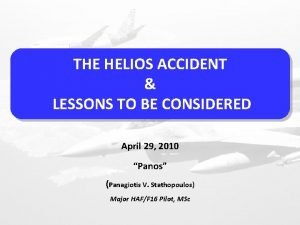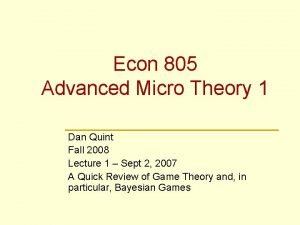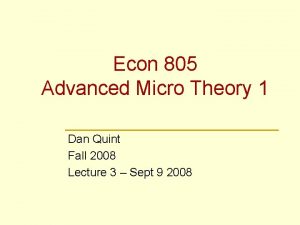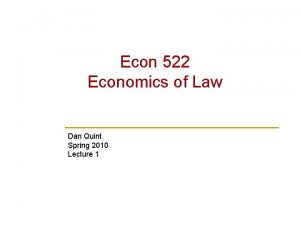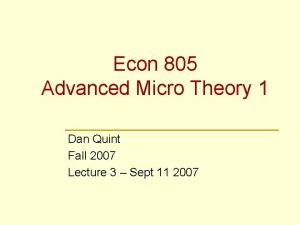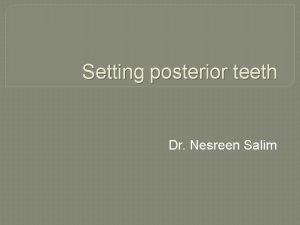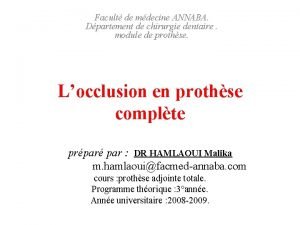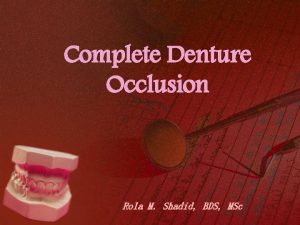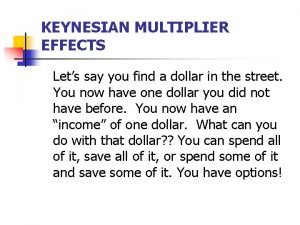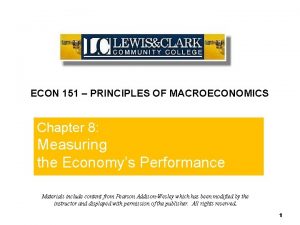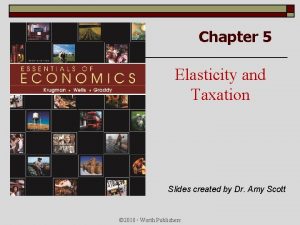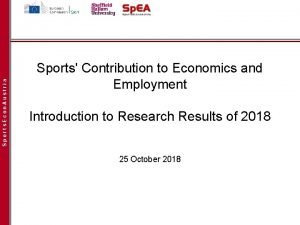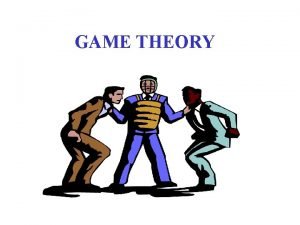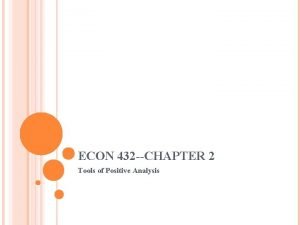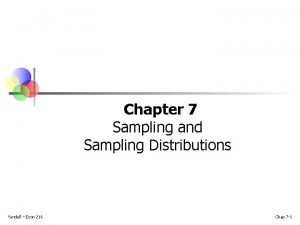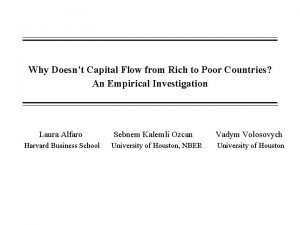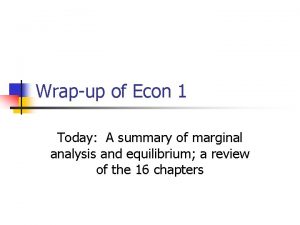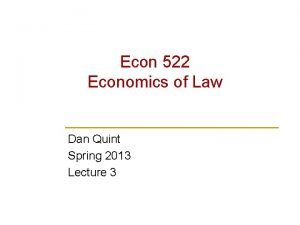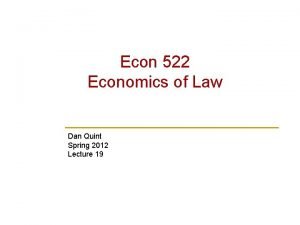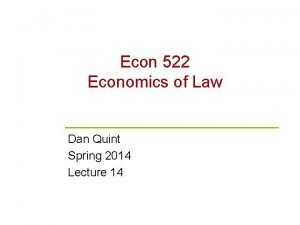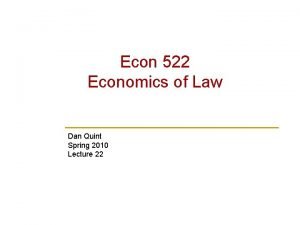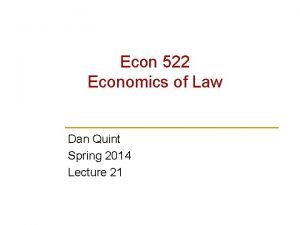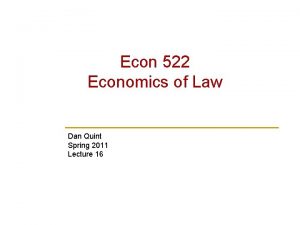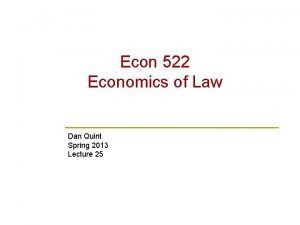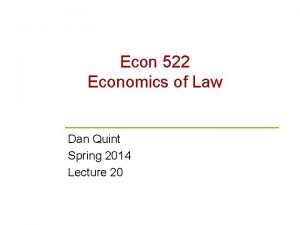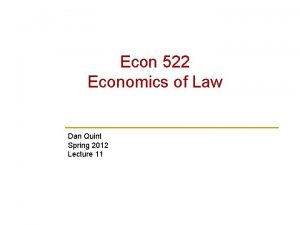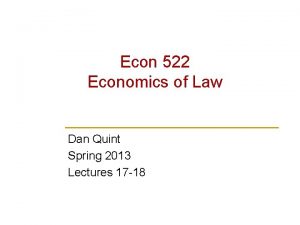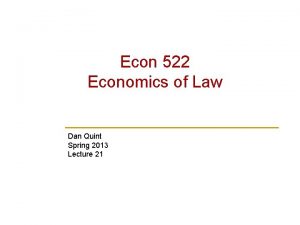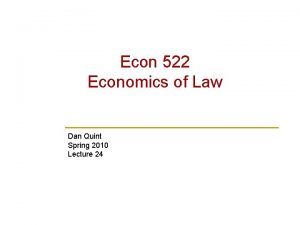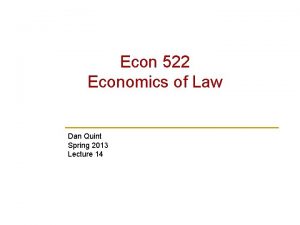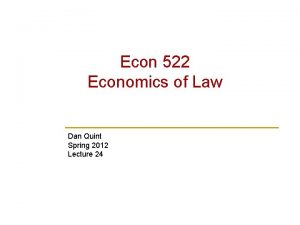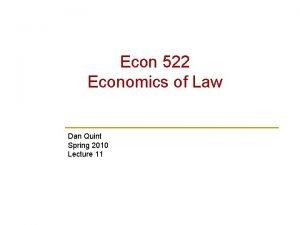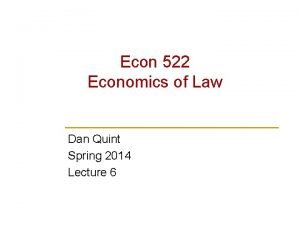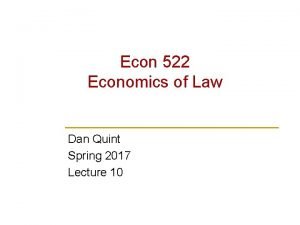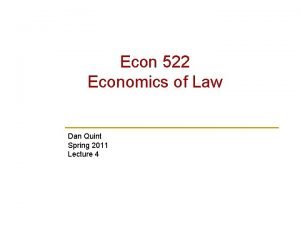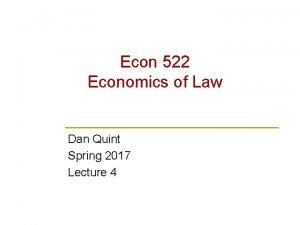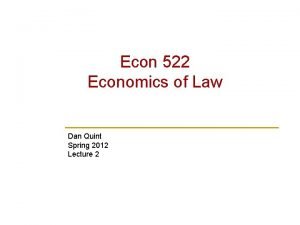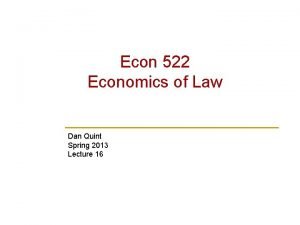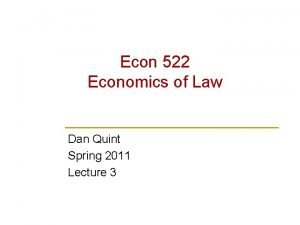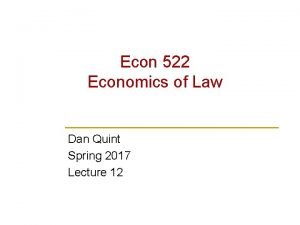Econ 522 Economics of Law Dan Quint Spring














































- Slides: 46

Econ 522 Economics of Law Dan Quint Spring 2010 Lecture 21

The legal process 1

Last Wednesday, we… w Formulated the goal of the legal process Minimize social costs, which consist of: w Administrative costs, and w Error costs w w Broke the legal process into a series of steps, and discussed a couple of them w Today: More on the legal process w Crime and criminal law w 2

Stages of the legal process… decision to pursue a legal claim bargaining over out-of-court settlements pre-trial exchange of information trial itself appeals process 3

Stages of the legal process… decision to pursue a legal claim bargaining over out-of-court settlements pre-trial exchange of information trial itself appeals process 4

Trial w In Europe… Judges in civil trials take active role in asking questions and developing case w “Inquisitorial system, ” since judge asks questions w w In U. S… Lawyers’ job to develop case w Judge is more of a passive referee w “Adversarial system, ” since competing lawyers are adversaries w 5

Incentives w Lawyers have a strong incentive to win at trial May be working on contingency w Value reputation for winning w w Judges have no stake in outcome of the trial Judges will (we hope) generally do what is right… w …but have less motivation to work hard w w “Judges have incentives to do what is right and easy; lawyers have incentives to do what is profitable and hard. ” 6

Who pays the costs of a trial? w In U. K. , loser in a lawsuit often pays legal expenses of winner Discourages “nuisance suits” w But also discourages suits where there was actual harm that may be hard to prove w w In U. S. , each side generally pays own legal costs w But some states have rules that change this under certain circumstances 7

Who pays the costs of a trial? w Rule 68 of Federal Rules of Civil Procedure “At any time more than 10 days before the trial begins, a party defending against a claim may serve upon the adverse party an offer [for a settlement]… If the judgment finally obtained by the offeree is not more favorable than the offer, the offeree must pay the costs incurred after the making of the offer. ” w “Fee shifting rule” w Example I hit you with my car, you sue w Before trial, I offer to settle for $6, 000, you refuse w If you win at trial, but judgment is less than $6, 000… w …then under Rule 68, you would have to pay me for all my legal expenses after I made the offer w 8

Who pays the costs of a trial? w Rule 68 does two things to encourage settlements: Gives me added incentive to make a serious settlement offer w Gives you added incentive to accept my offer w w But not actually as generous as it sounds w Attorney’s fees not always included in fees that are covered w Asymmetric Plaintiff is penalized for rejecting defendant’s offer w Defendant is not penalized for rejecting offer from plaintiff w 9

Who pays the costs of a trial? w Kathryn Spier, “Pretrial Bargaining and the Design of Fee. Shifting Rules” Game-theory analysis of Rule 68 and similar rules w Shows that when parties have private information, fee-shifting rules like this increase probability of settlement w Then considers designing “perfect” rule to maximize number of cases that would settle out of court w Ideal rule is similar to two-sided version of Rule 68 w Take each side’s most generous settlement offer Compute a cutoff If eventual judgment is below this cutoff, plaintiff pays both sides’ legal fees; if above cutoff, defendant pays both sides’ fees 10

Unitary versus Segmented Trials w Trial has to answer two questions: Is defendant liable? w If so, how much are damages? w w Unitary trial considers liability and damages at same time w Economies of scope w Segmented trial considers liability first, then damages later (if necessary) w Damages phase may not be necessary w In U. S. , judges have discretion over which type of trial 11

Burden of proof w Burden of proof: who is responsible for showing what at trial In criminal case, prosecutor’s burden to show defendant is guilty, not defendant’s burden to show he’s innocent w Similarly, in civil case, plaintiff’s burden to make case w Under negligence rule, plaintiff has to prove defendant was negligent (rather than defendant having to show he was not) w Under contributory negligence, once defendant is shown to be negligent, it’s defendant’s burden to show plaintiff was also negligent w 12

Standard of proof w Standard of proof: degree of certainty to which something must be shown in court In criminal cases, “beyond a reasonable doubt” – very high standard w In civil cases, plaintiff usually has to prove case by “a preponderance of the evidence” w w Much lower standard –interpreted as anything over 50% certainty For punitive damages to be awarded, high standard of proof is often required: “clear and convincing evidence” w Efficient level depends on relative costs of two types of errors Finding someone liable when they should not be w Finding someone not liable when they should be w 13

Rules of evidence w Rules for what evidence court can pay attention to w Textbook gives examples where rules seem inconsistent, if goal is simply to maximize probability of “right outcome” w When we focus on efficiency, we care only about outcomes, not about process w But in real-world legal system, process is important in its own right 14

Stages of the legal process… decision to pursue a legal claim bargaining over out-of-court settlements pre-trial exchange of information trial itself appeals process 15

Appeals w In U. S. , three levels of federal courts District courts, circuit courts of appeals, Supreme Court w (Many state court systems also have three levels, but this varies by state) w Parties in district court cases have right of appeal w w Circuit court is required to consider their appeal Parties in circuit court cases do not Supreme Court has discretionary review – chooses which cases to hear w In common law countries, appeals courts tend to only consider certain issues Appeals generally limited to matters of law w Matters of fact generally not considered w 16

Appeals w Recall goal of legal system w Minimize administrative costs + error costs w Clearly, appeals process increases administrative costs w So only efficient if it reduces error costs w Reasons why appeals process may reduce error costs Appeals courts are more likely to reverse “wrong” decisions than “right” decisions… w …which leads to losing parties appealing more often when decision was “wrong” w 17

Criminal Law 18

What is the goal of criminal law? w Just like with civil law… w To achieve efficiency, we want to minimize total social cost w Which consists of… Social cost of crimes that are committed w Cost of detecting and punishing offenders w 19

Criminal law differs from civil law in several ways w Criminal intended to do wrong w Case brought by government, not individual plaintiff w Harm done tends to be public as well as private w Standard of proof is higher w If found guilty, defendant will be punished 20

Intent w Unlike a tort, a crime generally requires intent w Mens rea – a “guilty mind” w But… w In some situations, literal intent is not required w You’ve been hired as a lifeguard or a nurse You show up to work drunk, and as a result someone dies You can be charged with criminally negligent homicide even though you didn’t want the person to die Sometimes intent without harm is enough Attempted murder 21

Criminal cases are brought by the state w Recall wrongful death tort cases Victim is dead, can’t receive compensation w Family/friends can sue for lost wages, lost companionship, etc. w w Criminal cases don’t require living victim w This allows prosecution of “victimless crimes” Theory is that all crimes harm the public – are “public bads” w That is, breakdown of law and order in society harms everyone w So public (represented by state) brings criminal actions w 22

Criminal cases have higher standard of proof w Most civil cases: preponderance of the evidence w For punitive damages, clear and convincing evidence w In criminal cases, prosecution must prove guilt beyond a reasonable doubt 23

Distinction between civil remedies and punishment w Nuisance law, contract law, tort law: damages serve two purposes Compensate the victim w Cause injurer to internalize cost of harm done w When injurer internalizes harm, we get pollution, or breach, or accidents, only when they are efficient w Criminal law: intention is to deter crimes – that is, prevent them entirely, not just the “inefficient ones” So punishment need not be limited to magnitude of harm done w Criminal punishments – imprisonment, execution – destroy resources w Make criminal worse off, may not make anyone better off 24

Are crimes ever efficient? w Most crimes are clearly inefficient To steal my laptop, you might break my car window w And, my laptop is worth more to me than to other people w Stolen cars are worth much less than legally-owned ones w And if you value my car more than me, there’s a legal alternative to you stealing it w 25

Are crimes ever efficient? w Most crimes are clearly inefficient To steal my laptop, you might break my car window w And, my laptop is worth more to me than to other people w Stolen cars are worth much less than legally-owned ones w And if you value my car more than me, there’s a legal alternative to you stealing it w w But Friedman offers examples of efficient crimes Starving hiker lost in the woods finds cabin with nobody home, breaks in and steals food w Efficient murder w Rich guy decides he’d derive immense pleasure from hunting a human Offers 10 people $1, 000 each to draw straws, he gets to hunt and kill the loser 26 If they all agree, is this transaction efficient?

Are crimes ever efficient? w In 2001, Armin Miewes posted an ad online, “looking for a well-built 18 -to-30 -year-old to be slaughtered and then consumed. ” w And someone answered. w They met, discussed it, and agreed Miewes would kill and eat the guy. w So he did. And videotaped it. w At the time, cannibalism was not illegal in Germany w Is it a crime to kill someone who has consented to be murdered? In 2004, Miewes was convicted of manslaughter w In 2006, he was retried, convicted of murder, sentenced to life in prison w w But also… if Miewes and his victim agreed he should be killed and eaten, and no one else was harmed, was this crime efficient? 27

Why not use tort law to cover crimes too? w Tort law creates an incentive to avoid harms w If it worked perfectly, might be no need for criminal law w Reasons tort law may not work for certain offenses w Relies on perfect compensation, which may be impossible Loss of life, crippling injury Even if possible in theory, might be impossible in practice w If probability of being caught/convicted is less than one, deterrence requires punishment more severe than benefit received w And if we made civil penalties severe enough, criminals might be judgment-proof w 28

Theory of criminal law w A theory of criminal law must answer… Which acts should be punished as crimes? w How should they be punished? w w Cooter and Ulen: Acts should be punished when aim is deterrence w Acts should be priced when aim is internalization w Aim should be deterrence when… w perfect compensation is impossible people want law to protect rights instead of interests or enforcement errors undermine liability w Rest of today is from ch. 15 of Friedman book (Law’s Order) 29

General model of crime and punishment 30

Economic model of crime and punishment w Key assumption: rational criminals w Potential criminals weigh private cost – chance of getting caught, times severity of punishment – against benefit w If enforcement were free, we could eliminate crime Hire enough police to detect nearly all crimes w Punish them very severely w Nobody rational would commit a crime w w But enforcement isn’t free, making things interesting 31

Economic model of crime and punishment w To deter crime, we need to do two things: Catch offenders… w …and punish them w w Catching a higher fraction of offenders is more costly w Requires more police, more detectives, etc. w More severe punishment also tends to be more expensive Most common punishments are fines and imprisonment w Fines cost nothing – state even makes money w But fines don’t always work, because not everyone can pay them w Besides fines, most punishments are inefficient – make offender worse off, and are costly to state w 32

Gary Becker, “Crime and Punishment: An Economic Approach” w Suppose some crime is punished by 20% chance of being caught and convicted, and a punishment equal to $20, 000 w We could save money by… w w w Fire half the police and judges, so probability of being caught and convicted dropped to 10% Raise the punishment to $40, 000 Punishing someone $40, 000 may cost more than punishing them $20, 000, but not more than twice as much… …and half as many people to punish So cost of punishing people would be same or lower But we’d save money on detection/apprehension w Repeating the argument, the “optimal” system is an infinitely low probability of an infinitely severe punishment! 33

Marginal cost of deterrence w With rational criminals, raising the expected punishment should lead to fewer crimes being committed w On a per-crime basis, raising either the probability of being caught or the severity of the punishment is costly w But as we increase expected punishment… we get fewer crimes committed, w and maybe fewer offenders we need to detect and punish w w So the cost of punishing those criminals we do catch could go up or down w Which means the marginal cost of deterring another crime could be positive or negative! 34

“The marginal cost of deterring another crime could be positive or negative” w Sample exam question (Fall 2008 final exam): Suppose a particular crime is always inefficient: it harms the rest of society $10, 000 more than it benefits the criminal. Every time an offender is caught, he or she is tried, convicted, and imprisoned; the total (social) cost of trials and punishment is $100, 000 per criminal caught. Recall that the aim of criminal law is to minimize the sum of three things: (1) the social cost of the crimes that are committed, (2) the cost of detection, and (3) the cost of trying and punishing the offenders who get caught. A city is considering hiring additional policemen dedicated to detecting this particular crime. This change would increase the fraction of offenders who get caught from 15% to 20%. 35

“The marginal cost of deterring another crime could be positive or negative” w w Social cost of each crime: $10, 000 Cost of trial and punishment: $100, 000 Increase fraction of crimes detected from 15% to 20% (a) Suppose this increase in detection would result in a decrease in the number of crimes committed from 1, 000 a year to 700 a year. i. Calculate the effect that hiring the new policemen would have on the social cost of crimes committed. before: 1, 000 X $10, 000 = $10, 000 after: 700 X $10, 000 = $7, 000 effect: $3, 000 reduction in social cost of crime ii. Calculate the effect it would have on the cost of trying and punishing offenders. before: 1, 000 X 15% X $100, 000 = $15, 000 after: 700 X 20% $100, 000 = $14, 000 effect: $1, 000 reduction in cost of trials and punishment iii. From an efficiency point of view, what is the most that the city should be willing to pay for the new policemen? $4, 000, since this is how much social costs are reduced by 36 having higher detection

“The marginal cost of deterring another crime could be positive or negative” w w Social cost of each crime: $10, 000 Cost of trial and punishment: $100, 000 Increase fraction of crimes detected from 15% to 20% (b) Now suppose instead that the increase in detection would decrease the number of crimes committed from 1, 000 a year to 900 a year. i. Calculate the effect that hiring the new policemen would have on the social cost of crimes committed. before: 1, 000 X $10, 000 = $10, 000 after: 900 X $10, 000 = $9, 000 effect: $1, 000 reduction in social cost of crime ii. Calculate the effect it would have on the cost of trying and punishing offenders. before: 1, 000 X 15% X $100, 000 = $15, 000 after: 900 X 20% $100, 000 = $18, 000 effect: $3, 000 increase in cost of trials and punishment iii. From an efficiency point of view, is there any positive amount that the city should be willing to pay for the new policemen? No – higher detection increases social costs, so even if the new policemen 37 were free, from an efficiency point of view, we wouldn’t want them!

“The marginal cost of deterring another crime could be positive or negative” w w Social cost of each crime: $10, 000 Cost of trial and punishment: $100, 000 Increase fraction of crimes detected from 15% to 20% (c) Defend the following statement applied to this type of crime: “Even when detection is cheap, more detection is only efficient if the supply of crimes is elastic. ” When the supply of crimes is inelastic, detecting more of them increases social costs – the number of crimes does not drop much, but more is spent punishing those who are caught. When the supply of crimes is elastic, detecting more of them reduces social costs – fewer crimes get committed, and fewer criminals need to be punished. 38

Optimal deterrence w So depending on how much the crime rate responds to deterrence, increasing the likelihood of being caught could… Reduce social costs – by reducing the number of crimes committed and the number of criminals we have to punish w Increase social costs – by increasing the number of criminals we catch and have to punish (in addition to requiring more spending on detection) w w What does this say about the optimal level of deterrence? Or, if you prefer, the optimal level of crime? w Or the optimal level of punishment? w 39

Optimal punishment – example Suppose there’s some crime for which expected punishment (probability X severity) equals $900 w Suppose raising expected punishment from $900 to $901 would deter exactly one crime. Should we do it? w Depends whether social cost of that one crime is more or less than the social cost of deterring it w Suppose that… w Raising expected punishment from $900 to $901 would cost $50 “Marginal crime” does $1, 000 worth of damage To calculate social cost, also need to consider benefit to criminal Marginal crime gets committed when expected punishment is $900, but not when expected punishment is $901; so benefit to criminal is $900 So social cost of that crime is $1, 000 - $900 = $100 If social cost of raising expected punishment enough to deter that crime is $50, we should do it! 40

Optimal punishment – general theory at efficient level of deterrence: since “marginal criminal” is indifferent… rearranging, Cost of deterring one more crime = Damage to Victim – Benefit to Criminal Cost of deterring one more crime = Damage to Victim – Expected Punishment = Damage to Victim – Marginal Cost of Deterrence Social cost of marginal crime 41

At efficient level of deterrence, Expected Punishment = Damage to Victim – Marginal Cost of Deterrence w When deterrence is free, expected punishment = damage to victim Offender internalizes costs of his actions w Just like with tort law, leads to only efficient crimes w w When deterrence is costly, expected punishment < damage to victim When preventing marginal crime is costly, we allow all efficient crimes… w …and some slightly inefficient ones, because it’s cheaper to allow them then to prevent them w w When marginal cost of deterrence is negative, we should set expected punishment > damage to victim When preventing the marginal crime saves money (because there are fewer criminals to punish)… w We prevent some efficient crimes too, because it’s cheaper to deter them than to allow them and have to punish them! 42 w

Aside: why do we count the criminal’s benefit? w Why count criminal’s payoff when calculating social costs? We said fines cost nothing – make offender worse off, state better off w Why not just say, screw the offender, fines raise money? w And social cost of crime = damage to victim – benefit to offender w Why not: by committing certain acts, you give up right to be counted? w w Friedman argues it this way: We want an economic theory for why things like murder and embezzlement should be treated differently than nuisances and torts w If we start out by assuming they’re morally different, we’re assuming the answer to our question w If we avoid making assumptions like that, and still come up with reasons they should be treated differently, then we’ve learned something 43 w

So what would the efficient criminal law system look like? w Friedman: “It would be designed to squeeze the largest possible fines out of convicted criminals, using the threat of more unpleasant alternatives for those who failed to pay. w If the fines that victims can pay, even under such threats, are inadequate, they are supplemented by penal slavery for criminals who can produce more than it costs to guard and feed them, execution (with the organs forfeiting to the state) for those who cannot. w Any prisons that do exist and do not pay for themselves are as unpleasant as possible, so as to produce as much punishment as possible per dollar of imprisonment cost. w It is a consistent picture, and considerable parts of it can be found in the not very distant past, but not a pretty one. ” w 44

The problem with efficient punishments w Punishments are designed to make someone worse off w So if they’re efficient, must be making someone better off w State gets to collect fines w But this creates large incentive for abuse Some feel too much police effort goes into drug cases, in which forfeiture of dealers’ money and property is common w Once traffic cameras are installed, towns realize catching speeders is profitable – article on syllabus lists six cities caught shortening length of yellow lights beyond what’s allowed by law w 45
 Andreas prodromou helios 522
Andreas prodromou helios 522 Numberblock 3000
Numberblock 3000 Po box 63000 newark nj 07101
Po box 63000 newark nj 07101 Nasa std 6001
Nasa std 6001 Cube of 522
Cube of 522 It-522
It-522 Dan quint
Dan quint Dan quint
Dan quint Dan quint
Dan quint Dan quint
Dan quint Econ
Econ Spring, summer, fall, winter... and spring (2003)
Spring, summer, fall, winter... and spring (2003) What are the months of fall
What are the months of fall Steep cusp
Steep cusp Factors influencing balanced occlusion
Factors influencing balanced occlusion Arc gothique dentaire
Arc gothique dentaire Balanced articulation
Balanced articulation Quad pent hex hept oct
Quad pent hex hept oct Centralesuplec
Centralesuplec Lateral compensating curve
Lateral compensating curve Newton's first law and second law and third law
Newton's first law and second law and third law Newton's first law
Newton's first law V=k/p
V=k/p Constant of avogadro's law
Constant of avogadro's law Maastricht university school of business and economics
Maastricht university school of business and economics Non mathematical economics
Non mathematical economics Newton's second law of motion
Newton's second law of motion Government expenditure formula
Government expenditure formula Fiscal policy ib
Fiscal policy ib Flipitecon
Flipitecon Econ 151
Econ 151 Midpoint method formula
Midpoint method formula Mps ap macro
Mps ap macro Marginal analysis in economics
Marginal analysis in economics Sports econ austria
Sports econ austria Econ 1410
Econ 1410 Econ 424
Econ 424 Mr darp econ
Mr darp econ What is game theory
What is game theory What is a positive analysis
What is a positive analysis Econ 134
Econ 134 Econ
Econ Econ chapter 7
Econ chapter 7 Esf muni harmonogram
Esf muni harmonogram Gertler econ
Gertler econ Economics velocity formula
Economics velocity formula Econ
Econ
